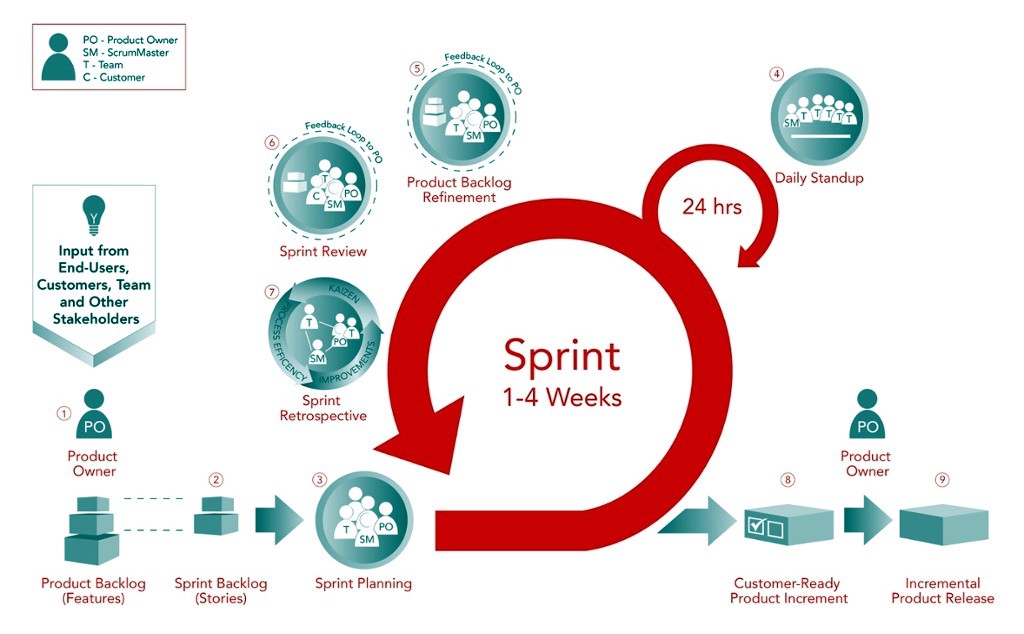How Scrum works and Where Scrum can be used?

Becoming an expert Scrum Master requires dedication and practical experience.
This comprehensive guide answers common questions on mastering Scrum – How Scrum Works and Where Scrum can be used, from understanding the framework to unlocking the full potential of the Scrum Master role.
Learn the key skills Scrum Masters need, their day-to-day responsibilities, and how they collaborate with the Product Owner for successful agile product development.
Get tips on gaining hands-on Scrum experience through training courses and resources. Master the art of facilitating teams through Scrum rituals while removing impediments and fostering continuous improvement.
Mastering Scrum: A Guide for Aspiring Scrum Masters
Scrum has become one of the most popular agile frameworks for managing complex projects. As a lightweight and flexible approach, Scrum enables teams to deliver products incrementally and adapt quickly to changing requirements.
To reap the full benefits of Scrum, organizations need certified Scrum Masters who can coach teams on Scrum values, practices, and processes. This article provides answers to common questions on mastering the Scrum Master role.
Scrum Basics: What is Scrum and How Does it Work?
Scrum is a framework centered around iterative development called “sprints”. Sprints typically last 2-4 weeks and include daily ” standups ” meetings. At the end of each sprint, teams demonstrate a shippable product increment.
The three pillars of Scrum are transparency, inspection, and adaptation.
Scrum is a framework centered around iterative development called “sprints”. Sprints typically last 2-4 weeks and include daily meetings called “standups”. At the end of each sprint, teams demonstrate a shippable product increment.
The three pillars of Scrum are transparency, inspection, and adaptation. Scrum creates transparency in the project by having artifacts like:
- User stories (or Tasks) – Requirements are listed as short descriptions of desired functionality from the user’s perspective.
- Sprint backlog – The subset of product backlog items the team commits to complete in a sprint.
- Product backlog – A prioritized list of all desired features, requirements, and bug fixes for the product.
The sprint reviews and retrospectives enable inspection of progress and processes.
In the sprint reviews, the team demonstrates the new functionality to stakeholders and gathers feedback.
The sprint retrospectives are meetings for the team to discuss what went well, what can improve, and ideas to optimize processes and team collaboration.
Based on these inspection opportunities, teams can adapt their plans and processes to optimize value delivery in the next sprint.
For example, they may break down user stories differently, improve testing approaches, or experiment with different collaboration strategies.
The transparency, inspection, and adaptation in Scrum empower teams to continuously improve and deliver value faster.
Scrum Team: Roles and Responsibilities
The Scrum team consists of the Product Owner, Scrum Master, and developers.
The Product Owner represents the business/customer and is responsible for prioritizing the work in the product backlog.
The Scrum Master coaches the team on Scrum processes, facilitates events, and removes impediments.
The developers are cross-functional and accountable for delivering shippable increments each sprint.
Scrum Events: The Sprint Cadence
Scrum prescribes five events that create regularity and minimizes the need for meetings.
- Sprint planning – The team collectively defines sprint goals and selects product backlog items to work on in the coming sprint.
- Daily standups (Daily Scrum) – Short 15-minute daily sync meetings for the team to share progress and identify blockers.
- Sprint reviews – Held at the sprint end for the team to demo the increment to stakeholders and discuss the next steps.
- Sprint retrospectives – The team reflects on processes and team dynamics to identify improvements for the next sprint.
- Backlog refinement – Ongoing activity to prepare and prioritize the product backlog for upcoming sprints.
There are skills and best practices for getting the most from each Scrum event. You can start learning them for free by clicking here.
Becoming a Scrum Master: Skills, Responsibilities, and Misconceptions
The Scrum Master role is often misunderstood as merely a meeting facilitator.
The Scrum Master role is often misunderstood because it entails much more than facilitating meetings, requiring a breadth of technical, functional, and soft skills to coach teams on Scrum processes, shield them from disruption, and enable continuous improvement.
However, a Scrum Master needs technical, functional, and soft skills to coach teams.
Key Skills
- Facilitation and conflict resolution – Ability to effectively guide team discussions and resolve disagreements.
- Coaching and mentoring – Develop team members’ skills through advice, encouragement, and leadership.
- Process expertise – Deep understanding of Scrum principles and ability to customize frameworks for teams.
- Servant leadership – Lead by serving team needs first rather than controlling them.
- Technical awareness – Understand development practices to advise teams on continuous improvement.
Core Responsibilities
- Guide the team on Scrum theory and practice – Ensure the team adheres to Scrum processes and principles.
- Promote self-organization and cross-functionality – Facilitate team collaboration without directing tasks.
- Shield the team from external interference – Protect team focus and productivity.
- Address impediments and facilitate collaboration – Remove roadblocks and foster engagement.
- Coach the Product Owner on backlog management – Help prioritize and groom the product backlog.
- Improve team dynamics and engineering practices – Enable continuous improvement of how the team works.
Common Misconceptions
- Scrum Masters are not project managers – they facilitate processes rather than assign tasks.
- Scrum Masters do not manage or direct the team – self-organizing teams manage their own work.
- Scrum Masters are not optional – they are crucial to guide teams in Scrum and maximize return on investment.
While Scrum certification validates foundational knowledge, hands-on practice is vital for mastering the Scrum Master role. With the right mindset and skills, Scrum Masters can help transform team collaboration and product development.
Difference between Scrum Master and Product Owner
The Scrum Master and Product Owner play complementary roles focused on the team and product.
The Scrum Master guides the team on Scrum processes and shields them from external interference. The Scrum Master has no authority over the team and promotes self-organization.
The Product Owner is responsible for product vision and prioritizing the product backlog to maximize business value. The Product Owner ensures the team works on the most critical features first.
While the Scrum Master coaches the team on how to work effectively, the Product Owner clarifies what the team should deliver in each sprint. Their collaboration enables the team to build valuable products using Scrum.
Can a Scrum Master be a Product Owner?
It is not recommended for a Scrum Master also to take on the Product Owner role. The two roles have conflicting focuses that can create tension:
- The Scrum Master aims to boost team productivity while the Product Owner wants to maximize business value.
- The Scrum Master facilitates while the Product Owner provides direction.
- The Scrum Master removes impediments while the Product Owner often creates them by pushing the team to deliver more.
Trying to juggle both hats can hinder a Scrum Master from being fully present for either role. For Scrum teams to thrive, it is best to have dedicated Product Owners and Scrum Masters.
What does a Scrum Master do all day?
Scrum Masters stay busy facilitating events, coaching the team, and eliminating barriers. Here’s an overview of how Scrum Masters may spend their days:
- Facilitate daily standups, sprint planning, reviews, and retrospectives – Keep meetings productive and focused.
- Promote Scrum values and empiricism – Ensure the team adheres to Scrum principles and self-organization.
- Coach team members – Help individuals improve technical skills, collaboration, and productivity.
- Work with Product Owner – Assist with grooming the product backlog and planning sprints.
- Remove impediments – Address issues limiting team productivity and momentum.
- Improve engineering practices – Guide teams on continuous integration, test automation, and other technical best practices.
- Enforce timeboxes – Ensure events happen within prescribed time limits.
- Capture metrics and improvements – Analyze data to provide insights that improve team performance over time.
Although each day is different, Scrum Masters stay busy enabling teams to deliver greater value with improved agility.

Where Scrum can be used?
Scrum can be used to manage complex work across diverse industries including software, manufacturing, marketing, and consulting. The flexibility of the framework allows it to be customized for different environments. Here are some of the most common domains where Scrum delivers results:
- Software Development: Scrum is exceptionally well-suited for software development as it enables iterative delivery of products and rapid adaptation to changing requirements. The short sprints encourage regular customer feedback and continuous integration. Top software companies like Google, Microsoft, and IBM leverage Scrum to build innovative digital products and services.
- Product Development: For physical products requiring design, prototyping, and manufacturing coordination, Scrum provides a structure for cross-functional teams to work iteratively without wasting time in silos. Automotive, consumer goods, and medical device companies use Scrum to bring products to market faster.
- Services: Scrum can manage service-related projects from HR initiatives in Fortune 500 companies to ad campaigns at agencies. Sprints instill accountability to move initiatives forward amidst competing priorities. Regular retrospectives help teams refine service delivery practices.
By providing transparency, inspection opportunities, and flexibility to change course quickly, Scrum can drive productivity across industries dealing with complex, rapidly evolving work.
Start Learning Scrum for Free
If you’re inspired to become an expert Scrum Master, enroll in Scrum training courses to gain practical experience. Check out these free resources:
- Scrum Guide https://www.scrumguides.org/ – Official Scrum reference book
- Learn Scrum for Free with our comprehensive step-by-step guide
Conclusion
Scrum adoption continues rising because it helps teams navigate complexity and deliver value faster. As businesses face disruption, only organizations that can rapidly inspect, adapt, and respond will thrive. Mastering Scrum is key to engagement, innovation, and resilience.
Mastering Scrum requires diligence, patience, and a commitment to continuous improvement. With the right foundation, you can enable teams to deliver amazing products using Scrum.
With the right mindset and commitment to continuous improvement, anyone can become an empowering Scrum Master. Consider embarking on this journey to enable teams and transform organizations in today’s dynamic business landscape.
To continue learning about Scrum for free, follow our Scrum blog where we share practical tips and insights. By mastering Scrum together, we can unlock better ways of working that translate to happier teams and delighted customers.
The future of work is agile – let’s Scrum it!
